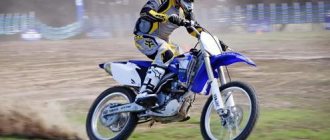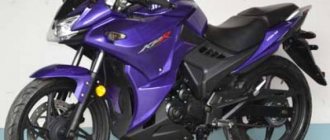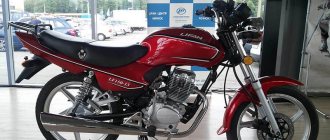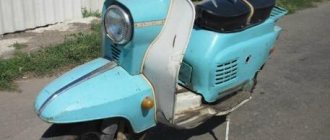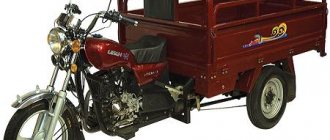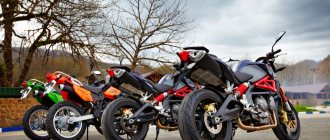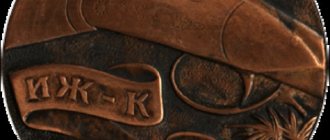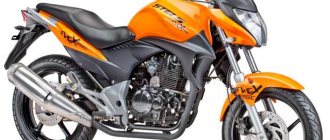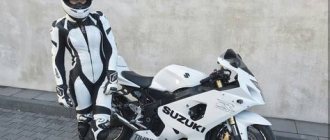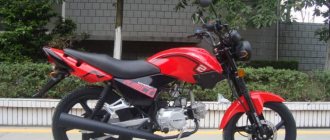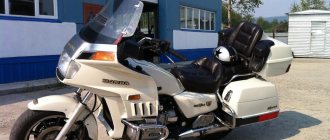JS125-28G
Chinese motorcycle Jianshe JS125-28G manufactured by Chongqing Jianshe Motorcycle Co., Ltd. (manufacturing plant in Zhongqing, Zhongqing Municipality, China; produces a variety of motorcycle equipment under the Jianshe , including motorcycles). Max. speed 90 km/h, curb weight of the Chinese motorcycle 120 kg, total seats 2 (including driver), total weight 270 kg.
Technical characteristics of the Chinese Jianshe motorcycle
general information
| Brand | Jianshe |
| Model | JS125-28G |
| Type | Motorbike |
| Manufacturer | Chongqing Jianshe Motorcycle Co., Ltd. |
| Country of manufacture | China |
| Location of production | Zhongqing, Zhongqing Municipality, China. |
Dimensions and weight of the Chinese motorcycle Jianshe JS125-28G
| Dimensions and weight characteristics of the Chinese motorcycle | |
| Dimensions of a Chinese motorcycle | |
| Overall length, mm | 2050 |
| Overall width, mm | 740 |
| Overall height, mm | 1150 |
| Weight | |
| Curb weight of the Chinese motorcycle, kg | 120 |
| Total weight, kg | 270 |
| Number of seats | |
| Total number of places | 2 |
Wheels and tires
| Wheels and tires of the Chinese motorcycle Jianshe JS125-28G | |
| no data |
Other technical characteristics
| Miscellaneous Specifications of Jianshe JS125-28G (motorcycle) | |
| Maximum speed | 90 |
| Total number of places | 2 |
Additional Information
Additional lamps (with photo) (Note: inaccuracies may occur)
Hello everyone! For a long time there have been requests to describe the modifications of my small-capacity vehicle for long-range tourism. I’ll say right away: all the modifications withstood the last tough Georgian-Turkish tests, but comments and thoughts appeared. Who is interested in the topic of autonomous, budget, small-capacity motorcycle tourism and all sorts of technical perversions designed to at least somehow simplify it, welcome to the cat. I repeat for those who have not read the previous posts, the bike was bought to replace the EBR, it is assembled at the same factory, the engine is one to one, The suspension and almost all consumables fit from the outside. Yes, it was an experiment, and it seemed to be a success. My modifications to the motorcycle have already become standard: 1 Self-made tourist motorcycle rack, not symmetrical, as usual, 16 pipes, homemade pipe bender, semi-automatic, powder coated. This time I did not make it one-piece and decided to leave the factory top luggage rack. I like the theme of the shelves protruding to the side, but it’s not aesthetically pleasing, but it saves you from falls (there were probably over 20 on this trip). The manufacturing process, in the photos there is a stock rear cylinder that does not hold even dry soil
Painted
Test drive
In combat boot, with a petroshin on the back
I also made a folding backrest, but this collective farm did not install it) although the thing is convenient for a long trip
The trunk works with standard waterproof bags for water trips and a sling with a lever tightening for almost all trips. The advantages of this symbiosis: tightness, simplicity, does not break when dropped, easy to seal if it’s already torn (I’ve never glued it). Cons: they can cut something in the parking lot (never happened), hemorrhoids when passing borders, or when you urgently need to get something from the bottom.
Thoughts of what I would change: - The trunk itself would now be changed towards practicality, rather than aesthetics. Those very shelves would have been shifted closer to the center of gravity of the bike, because with my fucking load of junk on the rear wheel, the handling, especially in the mountains, was not very good. — ideally, I would make a central case, where to lock something not particularly valuable, and two hermetic bags, but converted, with exits in the upper part, so as not to remove the entire bag if you need to get it out of the depths. — I would have taken out the turn signals, like on the trunk of the previous one (well, I was just too lazy and time was running out)
2 Wind deflector. I work in the field of plastic repair. Therefore, I stupidly turned to partners who repair snowmobiles and ATVs and asked for chopped “burdock” from a snowman. Using the method of tweeting with a marker, I chose an acceptable silhouette and used a jigsaw and a plastic file to finish it to suit myself. The burdock is gorgeous, big, cuts off well, I haven’t noticed any excessive fuel consumption, plus high-quality bourgeois cast polycarbonate is a general theme! (I can’t count how many times I fell on him and I’m still alive!!!). I laser-cut the front fasteners according to my drawings from 2mm stainless steel; I was too lazy to work on the fasteners for the steering wheel, so I made them from 6-inch studs and a rubber hose. The fasteners are naturally made with rubber gaskets.
I wouldn't change anything about the windshield, the only thing would be to add a small adjustable cut-off.
3 As usual, I took the front arches from Izh and screwed up my lower mount. The top mount is factory. I have long wanted to close the frame at the bottom and did it) I used iron from a landfill plus powder coating. It’s difficult to judge how much more rigid the frame has become), but the arches are strong, plus there is no protection from the stones that I ran over in the mountains.
Now I would make the arches a little higher, because in the mountains and ruts they clung to them.
4 Lower traverse. From the factory there was a 1 mm plate made of stainless steel and it seemed to me that the torsional rigidity of the fork was too small, especially for my purposes, and I made a traverse with which you can go at an elephant). 3 mm chernukha plus stiffeners, all welded with a continuous seam. I admit, I got excited. But the fork stiffness has increased, fact!
Now I wouldn’t bother so much with this traverse.
5 Where would we be without a gadget charger? Chinese, simple, from Aliexpress, brought to the steering wheel, wires, fuse and a small secret button on the side of the side cover.
6 I put standard corrugations on the fork for the ebrik, I didn’t take a photo. I put it on the ebr from something of our two-wheelers, they lived for two seasons. These Chinese cracked already on the first trip.
For those interested, thoughts and comparisons with the Ebr: 1 The Ebr is more collected on the road, but in my opinion the Jianshi has a more comfortable seating position, you sit lower, and the steering wheel is higher, which makes your back more comfortable. Maximum speed and cruiser are the same as ebr. 2 The stock tires on the Jiansha were absolutely not suitable for my purposes; after somersaults on the dusty road during break-in, I changed them to petroshins, which I was immensely happy about in the mountains of Georgia. 3 Pay attention! The nipples of the stock Chinese camera are much thinner than those of the domestic one, but the most important hole in the disk does not fit our camera at all!!! (it was a joke when I punctured the camera with a slam, but the spare camera wouldn’t fit!!!) 4 Gianshi is much stiffer than the eber, most likely due to the slightly larger offset of the front fork and 16 rear cylinder. 5 Jianshi does not have a fuel sensor, it’s annoying after ejaculation, but the suction on the steering wheel is very pleasant. 6 Change the number plate fastening IMMEDIATELY, otherwise the chance of losing it with a part of the wing is very high. 7 Fuel consumption is about the same as a little less than 3, but! In the mountains I encountered a strong carb glitch. I understand everything, but it’s normal to get rich in the mountains, but on the road with a vacuum carb it was not so obvious. So I gave up, I drove everywhere, the maximum speed reached was around 3000m on a rocky mountain road. All settings naturally returned when descending onto the plain. 8 Purely aesthetically, I like jianshi better, more strict or something. 9 For 9 thousand kilometers of hard use of just one trip, driving on stone paths in the mountains, fords, heat over 40, riding on Lukoil mineral water, nothing came loose, didn’t come loose, didn’t break. Even a stock chain will probably last just as long.
Something like this) Thanks to everyone who read. I will be glad if someone learned something useful! All the best and beaver!
see also
Jianshe motorcycle
Jianshe JS150-31 (motorcycle)
Jianshe
More details
| Manufacturer: | Chongqing Jianshe Mechanical & Electrical Equipment Co., Ltd. (China) | ||
| Working volume, cubic cm: | 150 | Total weight, kg: | 321 |
| Engine: | JS157MJ-2 | Power, kWt: | 11.8 |
| Tires: | 100/80-17130/70-17 | Fuel: | petrol |
| Speed, km/h: | 115 | Wheelbase, mm: | 1345 |
| Number of places, people: | 2 | Number of axes: | 2 |
| Curb weight, kg: | 141 | Number of tires: | 2 |
Jianshe JS150-32 (motorcycle)
Jianshe
More details
| Manufacturer: | Chongqing Jianshe Mechanical & Electrical Equipment Co., Ltd. (China) | ||
| Working volume, cubic cm: | 145 | Total weight, kg: | 317 |
| Engine: | JS158FMJ-2 | Power, kWt: | 8.1 |
| Tires: | 100/80-17130/70-17 | Fuel: | petrol |
| Speed, km/h: | 95 | Wheelbase, mm: | 1345 |
| Number of places, people: | 2 | Number of axes: | 2 |
| Curb weight, kg: | 137 | Number of tires: | 2 |
Jianshe JS150-7F (motorcycle)
Jianshe
More details
| Manufacturer: | Chongqing Jianshe Mechanical & Electrical Equipment Co., Ltd. (China) | ||
| Working volume, cubic cm: | 145 | Total weight, kg: | 271 |
| Engine: | JS158FMJ-2 | Power, kWt: | 8.1 |
| Tires: | 2.75-1890/90-18 | Fuel: | petrol |
| Speed, km/h: | 90 | Wheelbase, mm: | 1290 |
| Number of places, people: | 2 | Number of axes: | 2 |
| Curb weight, kg: | 121 | Number of tires: | 2 |
show all Other motorcycle equipment Jianshe
Will we love “octams”? We choose motorcycles up to 125 cm³
Subcategory of rights A1, which includes motorcycles with a displacement of up to 125 cm³ and a power of up to 11 kW (14.9 hp), is a resolved issue for Russia. So, we have reached the level of civilized countries, but should we be happy or sad about this? Previously, the “one hundred and twenty-five” niche was not particularly popular in our country and there was little technology. What awaits the market in 2012?
000_moto_0312_036
All motorcycles imported into Russia can be roughly divided into two categories: . However, this division is very arbitrary: even well-known models are “yellowish,” if not entirely made in China, Taiwan, or even Turkey, Indonesia and Vietnam. It is significant that famous brands usually have one or two “125” class models in their lineup. After all, this equipment is, as a rule, a training desk, which cannot be bypassed by law. And there will always be a demand for it, until the craving for motorcycling fades or the last drop of gasoline is burned. Only companies with image bikes (such as Harley, Victory or Ducati) do not condescend to unpretentious “sufferers”. But there are progress here too, an example of this is KTM (we’ll talk about it separately).
IT'S NOW CHEAPER
The “under 50” group (we are talking about thousands of rubles) is opened by two twins: Lifan LF125–5 and Patron Simpler 125, clones of the Honda CG125 model of 1976. Their appearance is archaic. A very common engine in China with a characteristic lower camshaft (OHV design) is installed in an open steel frame. This shaft has only one cam, which, through two pairs of rocker arms and a rod, controls two valves in the head. The engine turned out to be compact, lightweight, reliable, there are no problems with spare parts or repairs. And the devices themselves are extremely simple: drum brakes, primitive spring suspensions, passenger footrests are attached to a pendulum made of a thin round pipe, which does not pretend to be rigid. Fans of the style of the late 1970s, and indeed old hardware in general, will appreciate the shape of the tank, stylish markings, 18-inch spoked wheels, fenders and seat base made of natural steel. There is a lot of chrome, a strong trunk, a tachometer and an electric starter. On the training “figure”, the motorcycles are simply super: light as a bicycle, the angle of rotation allows you to pass the figures with a margin, and neutral is easily caught. Brakes on the training ground are not particularly needed, it is even valuable when they are weak, so as not to accidentally block the wheel and trip. But on the road you feel uncomfortable with these, especially in the city.
A little further from the border of primitivism is the Patron Aero 125F. It is equipped with the same “tsegesh” four-stroke “air vent”, but with glimpses of modern design. There are cast five-spoke wheels, more advanced suspensions and a sporty-looking muffler a la Akrapovich. The view is no worse than that of its Yamaha classmate (we’ll get to that later), but the price of the Aero is almost half as much.
Not far from this technology are the Minskis, of which there is a whole range on our market. Actually, the “125” cubic capacity has become the crowning glory for Belarusian cars since 1951, when they began producing a copy of the German DKW RT125. The descendant with a two-stroke engine is today called Minsk M125. The motorcycle does not have a separate lubrication system and an electric starter (there is no battery either), with a four-speed gearbox. Spoke 18-inch wheels - with drum brakes (there may be a disc at the front, but you need to look for such equipment), a durable closed-type frame is used, a sealed chain casing, suspension - with “hydraulics”. Minsk M125X with the self-explanatory name “Forester” is equipped with a durable three-sided trunk, headlight protection combined with a small trunk and an “upper” plastic wing.
But the Minsk C4 125 with a 4T engine is priced out of our group, but it is logical to consider it along with the others. After all, in fact, it eliminates all the shortcomings of simple Minsks: it has an electric starter, a front disc drive and a five-speed transmission. True, I had to sacrifice the chain casing. Although Minsk is cast on the cover of the unit, it is produced by the famous Chinese company Zongshen. This is not a clone of a Honda engine, but a Yamaha one, in which the camshaft is located in the head (ONS diagram). This classic-looking device is very good for both beginners and rural residents, many of whom still have Soviet two-stroke bikes from Minsk in service.
PRETEND TO BE A MOPED?
Although devices in the guise of a classic scooter are popular in Europe and are even updated by such giants as Honda, Yamaha, Suzuki, they are not brought to us - they are not prestigious and expensive. And most importantly, the small demand is fully satisfied by the Chinese motorcycle industry: cheap and cheerful. Although you rarely see the “125” cubic capacity, these are usually engines of 90–110 cm³. Examples on our market are Irbis Irokez 125, Patron Ringer 110. Like all scooters, they are attracted by improved protection from wind and water, plus a semi-automatic transmission. That is, you still need to change gears, but you don’t have to think about the clutch and the possibility of stalling. What is especially valuable is that you can pass the traffic police exam on a scooter. In addition, these devices are extremely light, and large 17-inch wheels and a sufficient turning angle facilitate the passage of the “figurine”. And in city traffic you feel like a fish in water (the author knows this firsthand - he himself has covered 20 thousand km, mostly in the metropolis).
The 125 cc Orion 125/B motorcycle fits very well into a moped. It has small dimensions, thin wheels and an archaic appearance; traffic cops don’t even look in the direction of such “self-running bicycles”. However, the motorcycle features are obvious - the layout (tank between the knees) and the “manual” clutch of the “Kab” engine. A plus in relation to scooters is a fairly capacious tank (8.5 liters compared to 3.5 liters), and that’s probably all. There are no suspensions, the brakes are weak, the electrics are assembled somehow. The only good thing is the price, provided that the buyer’s hands grow from where they need to be...
The Sachs MadAss 125 is a completely different matter - a “Chinese” under a glorious German brand, it is not the first year on our market. The ascetic “naked” appearance and original design justify the name “Raging Ass”. The device, weighing only 95 kg, is designed for two, although without any special amenities. There is no smell of archaic or classic here - MadAss is equipped with “tenacious” disc brakes on both three-spoke wheels and two powerful lens headlights. In addition to its exterior, the motorcycle differs from scooters in its “manual” clutch and 16-inch wheels; in the cooling system there is an oil radiator. In city traffic it is nimble and agile, but for long journeys you will need a really mad ass...
The Celestial company with the star brand Sky Team is known for clones of Honda “Cab” “babies” such as Monkey, Dax and Gorilla. They are offered in the form of both “fifty dollars” and almost indistinguishable in appearance, but with the cubic capacity of motorcycles. These are Skymax (ST125–6A) and Gorilla (ST125–8A). Their advantages are high similarity to the original and compactness. However, the appearance of the bestsellers of past years in Europe does not awaken any feelings in the Russian buyer. And the compactness is good for storage and transportation (these models even enter the elevator with a whistle), but on the road there is a big drawback: a person on such a motorcycle is not visible in traffic. Therefore, I will not recommend that adults (and even more so teenagers) ride them around the city - it’s simply dangerous.
New this year is the KYMCO K-Pipe 125. The device has a motorcycle layout, however, like scooters, there is no “manual” clutch. Beginners will like the light weight and inability to stall, as well as the cool appearance. The production of K-Pipe is scheduled to begin in Kuoshung (where KIMCO's head plant is located) in March 2012, and it is expected to go on sale in mid-summer.
TIMELESS CLASSICS
The Taiwanese SYM XS 125 is, in fact, a variation on the theme of Yamaha’s “Yubi-era”, only not what is offered in Russia, but the European one (more on that a little later). The frame is connected through the power unit, but the latter is not a clone of the mentioned Honda CG series, but almost identical to Yamaha. The device is so canonical that there is nothing special to write about: disc-drum brakes, 18-inch wheels, five gears. Convenient for beginners, practical, with an ageless appearance. And at the same time with a completely humane price.
The Yamaha YBR125, perhaps the most popular in Russia among beginners, owes its success primarily to the brand. There is no shame in riding a motorcycle with an emblem in the form of three tuning forks. And few people care (and most don’t even know) that cars from Turkey are imported into Russia, in which the fuel injection declared on European websites is replaced by a carburetor, and the classic round headlight is rectangular with a shield of an incomprehensible shape. The price, compared to the almost identical SIM, seems overpriced. However, this does not detract from its riding qualities, and the motorcycle has deservedly become a training desk in most motorcycle schools.
Although the Chinese motorcycle industry is young, it seems that it is already ripe for the release of stylizations of the classics. Here, for example, is a new product for 2012 on our market - the BM Maxmen 125 model from the Kaliningrad Baltmotors, assembled at the large Chinese company Qingqi. The style of the motorcycle clearly gravitates towards the scramblers of the late 1960s; usually such nostalgic tricks are allowed by the masters of motorcycle construction, and then only in limited editions. And here you have style and an affordable price. And Chinci is not a bad company, it’s not for nothing that Peugeot is “friends” with it. They say that at one time the director there was sentenced to death for poor quality, after which things got better...
HOW BIG
The German-Chinese Sachs Roadster 125 is practically indistinguishable from the “bi-em” described above, and there are suspicions that they are birds of a feather. If there was a “Find Five Differences” competition, I would name the color of the engine, the lack of a lower fairing on the Saxon, the color of the plastic “flashing lights” - and that’s it. No, there’s also the price: the Russian “Chinese” one is significantly lower than the German one.
Small-capacity KYMCO Quannon EU3 - with sportbike features. Its 125 cc air-oil-cooled engine received a fuel injection system, which allowed it to comply with Euro-3 environmental requirements. The rear suspension has a monoshock absorber and 17-inch cast wheels. By the way, the Chinese meticulously tore up this model, and they installed more “cubic” engines of 150 and 200 cm³ (Sagitta Spitzer 150, Patron Sport 200, Stels SB200) into the clones. This partly equalizes the characteristics - where the “Kimkovites”, due to injection, a four-valve head and a more advanced 125 cm³ air-oil engine, “remove” 13 “horses”, the devices from the Middle Kingdom get, at best, the same amount, but with 200 “cubes”. True, the twofold difference in price should not be discounted...
Well, the fact that the “Quannons” run at 130 km/h (this is stated on the forums) is quite understandable wishful thinking, plus the effect of a tailwind on the descent. Still, with a power of 13 horsepower, you can’t fool physics, and although the bike has a semi-fairing, the landing is still quite vertical. However, the latter is not so bad: it is more convenient to ride a motorcycle in the city and improve basic skills. I wanted to say: learning - no, motorcycles in the “cheaper than ever” or “timeless classic” categories are better suited for learning. Rearward footpegs, a narrow handlebar with the handles pulled back and down, and a small turning angle are not at all what a training motorcycle needs.
The “octagons” of the Czech company Jawa Moto spol stand apart. sro This name still evokes strong nostalgic emotions among compatriots - the plant, which is more than 80 years old, at one time supplied over 2 million motorcycles to the USSR. The family of “125” class machines began to be produced a long time ago - in 1998, using 4T engines from the Taiwanese company CPI. At first these were clones of Honda’s CG series, later - more modern NX OHC circuits with quite high power for an “air blower” (12.8 hp). The frame is closed through the engine crankcase, the rear suspension is with a monoshock absorber, both wheels are equipped with disc brakes. The Dakar model is unique for our market in that it is a dual-purpose motorcycle, which is emphasized by the “chubby” 16-inch rear wheel, high front fender and handlebar guards. Unfortunately, there are no others like it: the good RT125D SUV from Hyosung almost didn’t survive in our market until the introduction of the A1. A more “parquet” modification is the Dandy, with a low front fender and 17-inch wheels with “quiet” tires. The maximum speed of both motorcycles is 110 km/h. Unfortunately, the price of devices from the Czech Republic is also unique, confirming the thesis that everything touched by a European hand becomes noticeably more expensive than products from the Celestial motorcycle industry...
SMALL CUMBER HI-TECH
One of these devices is the light sports bike Aprilia RS4 125. Last year it replaced the famous “two-stroke” RS 125. Naturally, this is a completely different device with completely different technical characteristics. The design and color of the “octagon” are borrowed from the company’s large-capacity sportbikes, which earn victories for the Italian brand on the race tracks. The new four-stroke engine has everything “grown up”: liquid cooling, a head with four valves, electronically controlled injection, a dry sump lubrication system, a six-speed gearbox. The motor meets strict environmental requirements. Matching the engine and chassis is an aluminum die-cast frame, an inverted fork with support pipes with a diameter of 41 mm. The passenger seat can be quickly removed and the motorcycle can be converted into a single seater. By the way, this particular motorcycle breaks all records for the cost of 125 cc machines in our market.
And another European company - KTM (Austrian, but a significant part of the shares belongs to the Indian company Bajaj) last year prepared an “entry class” naked bike 125 Duke. “Osmushka” is clearly aimed at young people, but it looks very mature and of high quality. It is equipped with a liquid-cooled DOHC engine with fuel injection. Its power is just under the “bar” of the limitation - 15 hp. at 9500 rpm. The chassis has not been forgotten either: the frame and pendulum are made of aluminum alloy, and the brakes use radial calipers. The fork is a “shifter” from WP with supporting pipes with a diameter of 43 mm. The rear tire has a class-record width of 150 mm. Along with the motorcycle, you will be able to purchase a lot of tuning components, such as petal brake discs, body kit elements, etc. They say there will also be a “cheating” switch that will allow you to squeeze all the juice out of the engine... as well as from the owner’s wallet. However, if you don't like the latter, take a look at the bikes at the beginning of this review...
